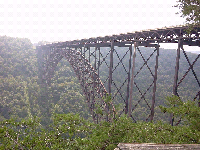
What an education Wow what a day. The day started off at Walmart. Well actually it was behind Walmart where in a wall of rock ther were about 8 holes that looked like punch mine holes but actually were tunnels for a deep mine. There was a construction crew there and the foreman told us that they were filling the mine with 30,000 yards of concrete to stabalize the mine so the Walmart complex would be safe. Next we went to Coal Mac a subsidiary of Arch Coal. This site is a surface mine that also has a small deep mine. Luckily for us it was vacation week so it was easy to get around the site, otherwise it would be very busy. Coal mining is needed because we still get 45% of our electricity from coal but the first 2 reclamations (not Coal Mac) we saw had positives but they also had negatives that needed fixed. The first site had biodiversity but had taken a long time to recover. The next site that man tried to reclaim in the seventies had recovered quickly and was green. Unfortunately the plants were very aggresive. The seed mix they sprayed kept other plants out so there was not much biodiversity, the plants were not native and it did not have much animals though I did see butterflies. The Coal Mac looked like they had learned from these previous lessons. They start their reclamation as soon as they start mining. When they remove the topsoil they set it aside for the reclamation. Then as soon as that section is done being mined they start the reclamation instead of waiting. First they get the land back to the original contour and put drainage in. Then they put the topsoil they saved back on and plant grass. Later they put a few trees in. Then they let natural sucession and bird poop to take over. It wasamazing how much diversity of plants they had in only 3 years and in 5 years it looked great. I did not realize that plants could grow back. I think their success came from man helping nature get a start but then letting natural succession to take over in making a native natural recovery. On the reclaimed land we saw bunnies, grasshoppers bees ( other insects) bear poop and saw and heard birds. In fact they said the bears had kind of become a nuisance. There are also turkeys, deer and coyotes. The coyotes are the only animal introduced there to help the coyotes. Ironically a techer here used to hunt squirrels in the woods and said there had just been squirrels and bunnies as larger animals there so the reclaimed land had more animal diversity. The reclaimed land had an orchard, ranch, and a golf course. If coal companies can be this successful then mining can be a win win situation. Next we visited Logan Airport. It was built on a mountain top removal site that was left flat. The mine reclamation must be returned to the original contour unless there is a plan approved ahead of time for commercial use. Finally we had dinner with some miner couples. This was very interesting. They allowed us to ask questions and told us their views. They were proud of what they do and seemed pleased that we had come to see what they did instead of just going by what was written in the papers. This is understandable because it seemed much different than what we saw. I asked about what kind of government regulation they thought was needed in the mines. The answer was that the mines needed regulations but the regulation should be streamlined and consistant. There are too many groups that regulate the mines and the rules keep changing. Also they feel that the regulations should match up with other companies. An example given was the regulation for the amount of selenium allowed in water for coal companies is 1/5 that of drinking water. They also acknowledged that there are a need for regulation. He also talked about the technology in the mines that is amazing. Another interesting comment made by the miner's wife was that as a real estate agent if they could use a mountain top smine sit to build houses they could sell 50 houses in no time because of the lack of land in Chapmanville and that there is a need to provide entertainment for the kids but there is not land for it. It was interesting to hear them talk about their experience and to hear their passion as they talked. They also said we could contact them if we needed more information that would help us teach about mining. I was very impressed by the work done at Coal Mac and especially with their people.













